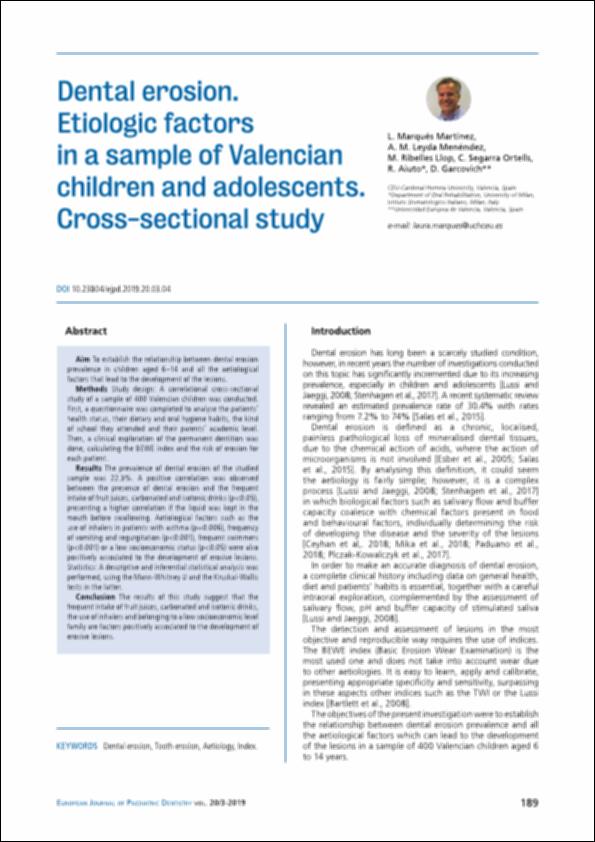Por favor, use este identificador para citar o enlazar este ítem:
http://hdl.handle.net/10637/15448Dental erosion: etiologic factors in a sample of Valencian children and adolescents: cross-sectional study
| Título : | Dental erosion: etiologic factors in a sample of Valencian children and adolescents: cross-sectional study |
| Autor : | Marqués Martínez, Laura Leyda Menéndez, Ana María Ribelles Llop, Marta Segarra Ortells, Cristina Aiuto, R. Garcovich, Daniele |
| Materias: | Dientes; Teeth; Erosión; Erosion; Etiología; Diseases-Causes and theories of causation |
| Editorial : | European Journal of Paediatric Dentistry |
| Citación : | Marqués Martínez, L., Leyda Menéndez, A.M., Ribelles Llop, M., Segarra Ortells, C., Aiuto, R. & Garcovich, D. (2019). Dental erosion: etiologic factors in a sample of Valencian children and adolescents: cross-sectional study. European Journal of Paediatric Dentistry, vol. 20, i. 3 (sep.), pp. 189–193. DOI: https://doi.org/10.23804/ejpd.2019.20.03.04 |
| Resumen : | Aim: To establish the relationship between dental erosion prevalence in children aged 6-14 and all the aetiological factors that lead to the development of the lesions. Materials and methods: Study design: A correlational cross-sectional study of a sample of 400 Valencian children was conducted. First, a questionnaire was completed to analyse the patients' health status, their dietary and oral hygiene habits, the kind of school they attended and their parents' academic level. Then, a clinical exploration of the permanent dentition was done, calculating the BEWE index and the risk of erosion for each patient. Results: The prevalence of dental erosion of the studied sample was 22.3%. A positive correlation was observed between the presence of dental erosion and the frequent intake of fruit juices, carbonated and isotonic drinks (p<0.05), presenting a higher correlation if the liquid was kept in the mouth before swallowing. Aetiological factors such as the use of inhalers in patients with asthma (p=0.006), frequency of vomiting and regurgitation (p<0.001), frequent swimmers (p<0.001) or a low socioeconomic status (p<0.05) were also positively associated to the development of erosive lesions. Statistics: A descriptive and inferential statistical analysis was performed, using the Mann-Whitney U and the Kruskal-Wallis tests in the latter. Conclusion: The results of this study suggest that the frequent intake of fruit juices, carbonated and isotonic drinks, the use of inhalers and belonging to a low socioeconomic level family are factors positively associated to the development of erosive lesions. |
| URI : | http://hdl.handle.net/10637/15448 |
| Derechos: | http://creativecommons.org/licenses/by-nc/4.0/deed.es Open Access |
| ISSN : | 2035-648X (Electrónico) |
| Fecha de publicación : | sep-2019 |
| Centro : | Universidad Cardenal Herrera-CEU |
| Aparece en las colecciones: | Dpto. Odontología |
Los ítems de DSpace están protegidos por copyright, con todos los derechos reservados, a menos que se indique lo contrario.


